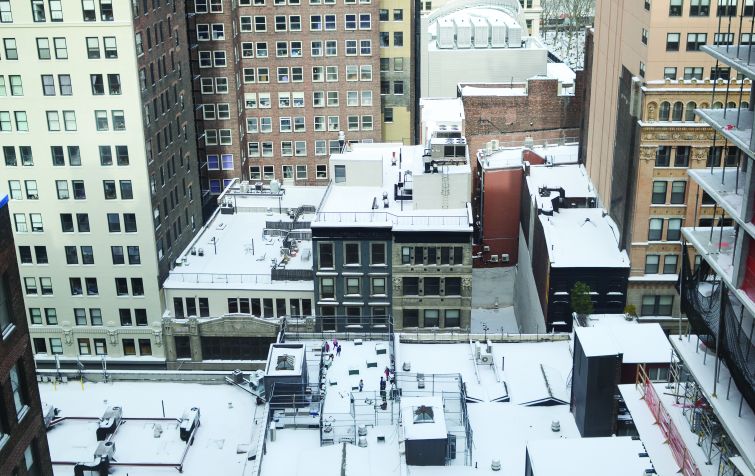How NYC Property Managers Deal With Adverse Weather
By Rey Mashayekhi March 23, 2017 9:45 am
reprints
Walking around Manhattan in the wake of last week’s blizzard, all the usual sights that accompany such a storm were there: New Yorkers hobbling over piles of snow gathered at the crosswalks, motorists digging out cars from the barricading snowfall and no shortage of rock salt on nearly every square inch of sidewalk.
There were other sights, though, more specific to the way New York City landlords and property managers must handle wintertime in a cold-weather city like ours. As well as the aforementioned rock salt, sidewalks were cordoned off with yellow caution tape to protect passersby from the threat of falling ice and snow. And though not visible from street level, precautions assumedly were taken to reinforce or remove any fixtures at risk of blowing off of the towering buildings.
Such are the measures that building managers must consider when faced with inclement weather. Managing property in New York City is a 24/7 commitment, and whether it’s preparing for nasty conditions or legislating for the pounding that a building takes year after year when facing those conditions, there is plenty to consider.
“It’s the responsibility of the property manager to have plans in place so that when you are hit with a storm, you are prepared,” said Brian McCann, a managing director at Cushman & Wakefield’s asset services group, which manages nearly 74 million square feet of commercial property in New York City. “There are a lot of things that need to be considered: Do you have enough calcium chloride or ice melt on hand? Are the snow plows operable? It all plays a pretty big part in the cost of preparing for a storm and the eventual cleanup.”
In the event of snow, in particular, most commercial landlords in New York rely on third-party contractors for removal—often the same companies they contract for custodial and janitorial services. The responsibility is usually built into the third-party firm’s cleaning contract, though the terms can vary. While McCann said costs can adjust depending on the amount of snowfall, JLL Managing Director Matt Duthie, who heads the brokerage’s property management business in New York, said that for his firm, they’re usually “baked into the number” paid for custodial services.
“Generally speaking, if they clean the building, [snow removal] is built into the contract,” Duthie said. “We don’t pay anything more, anything less for snow removal. This year, it really didn’t snow a lot, so the janitorial companies got off easy, but some years it can snow [heavily].”
Oftentimes, property managers will find themselves having to prepare for a forecast of snow overnight, like ensuring the proper manpower is available. McCann said C&W sometimes has to “put [workers] on standby,” even if that means assuming additional costs to ensure they’re able to get to the properties the next day.
“If you’re in Manhattan and there’s a storm that hits overnight, [sometimes] you can’t get people into Manhattan to clean up,” he said. “Sometimes, we keep them in Manhattan overnight and put them in hotels.” McCann said it’s an expense that property owners are often iffy about committing to: “Some landlords will pay [to put up workers in hotels], others will not.”
But clearing the snow and ice is imperative, not only for building accessibility but also as a matter of public safety and legal liability. Landlords are no strangers to the sorts of lawsuits filed by people who have slipped on an icy surface outside one of their buildings, and even more serious is the threat of ice falling to the ground from stories above.
In the case of the latter, property managers have to account for external characteristics at their buildings that may make them susceptible to falling ice and snow and take the necessary preventative measures—whether that’s clearing exterior building ledges or cordoning off sidewalk areas where the public may be at risk.
“Some of these buildings are designed to such an extent that if there are horizontal, flat surfaces on the [exterior], ice and snow can sit up there, and if it thaws, it falls and can hurt somebody,” Duthie said. “That’s why it’s important to take precautionary measures to make sure you’re protecting the public.”
And then there’s the matter of high-wind conditions, which are a constant issue in a city with as storied and prominent a skyline as New York. As in the case of other inclement weather conditions, the city’s Office of Emergency Management plays an important role in notifying landlords and property managers on days when the wind is gusting and to take precaution. There are also laws in place—namely, the city’s Facade Inspection Safety Program, commonly known as Local Law 11—mandating the periodic inspection of high-rise (seven stories or taller) building facades to ensure they can withstand the rigors of such conditions.
“We do an inspection with every high-wind forecast,” McCann said. “In a typical high-wind situation, forecast at over 25 miles per hour, we take precautions where we survey the roofs, setbacks, any place that’s exposed to make sure there’s no loose material.”
He added that “a good part of the time, something gets damaged in high-wind conditions,” whether it’s a loose piece of curtain wall or a damaged parapet. But that is simply part and parcel of running a building, McCann noted. “You do your inspection, you check your building and try to see if any damage has occurred,” he said.
Of course, it’s not just commercial landlords and managers who deal with this reality; those on the residential side of the business have their own unique set of challenges, though many of the same issues and requirements apply.
“Owning and operating an apartment building or a high-rise structure in this part of the country is a little bit different than it is in [other parts of the U.S.],” said Robert Nelson, the president of Nelson Management Group, which has owned and operated more than 7,500 units across the five boroughs. “We have freeze-thaw cycles that we go through every year. These are brick-and-mortar buildings, and it may rain on a 60-degree day last week, and a few days later, the temperature goes down to 21 degrees, and water may still be sitting up on the roof.”
Nelson said that while landlords can take preventative measures to “maintain the building’s envelope” and ensure heat and water pipes can withstand such varying conditions, “I don’t think that there’s a lot that you can really do with respect to your bricks”—at least beyond hoping the property is built to last and factoring in the costs of maintenance in the budget.
“As a building owner, you have to accept that when you underwrite the acquisition of a building, you need to have the proper reserve dollars because things happen,” he said. “It’s just a reality of owning these types of structures.”
Nelson did have one piece of advice, however, as far saving on the costs of property management in wintertime: “We buy all of our rock salt in the summertime.”


